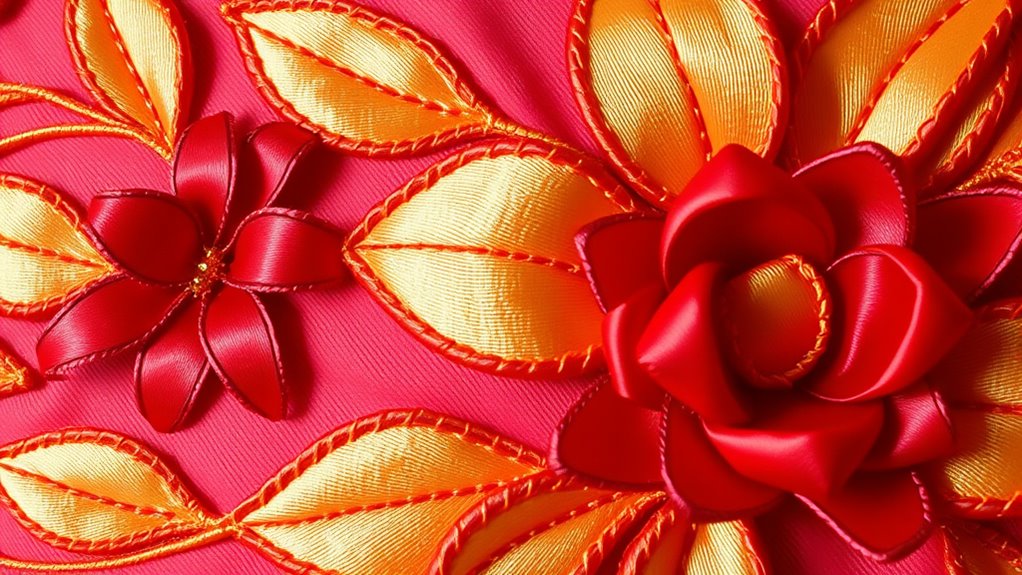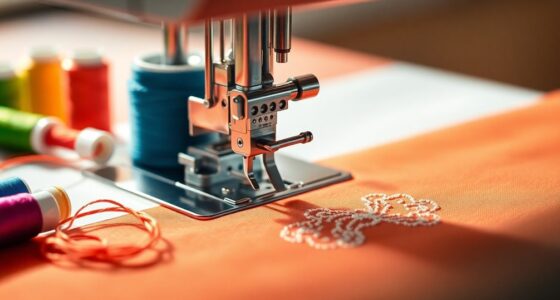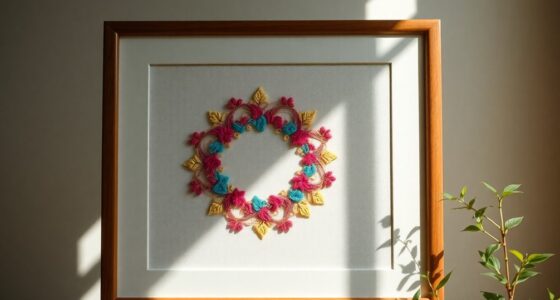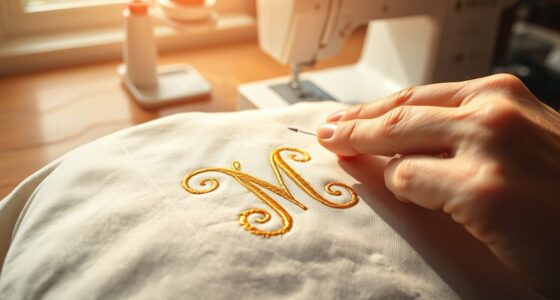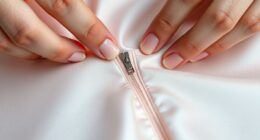To add dimension with ribbon work, choose smooth fabrics like silk, cotton, or linen for a steady base. Use sharp needles, tidy scissors, and vibrant ribbons to keep your stitches neat and even. Practice controlling your ribbon and stitches, keeping everything flat against the fabric. Patience and a good workspace make a big difference. Stay focused and experiment with different ribbons and stitches—more tips and techniques await as you continue exploring ribbon embroidery.
Key Takeaways
- Choose smooth, vibrant ribbons like satin or silk for a luxurious, dimensional effect.
- Use sharp needles and keep ribbons flat against the fabric to enhance three-dimensionality.
- Practice controlling stitch tension and technique for consistent, professional-looking results.
- Select a smooth fabric such as silk, cotton, or linen to support ribbon glide and neat stitches.
- Keep ribbons tangle-free and cut into manageable lengths to facilitate smooth embroidery work.
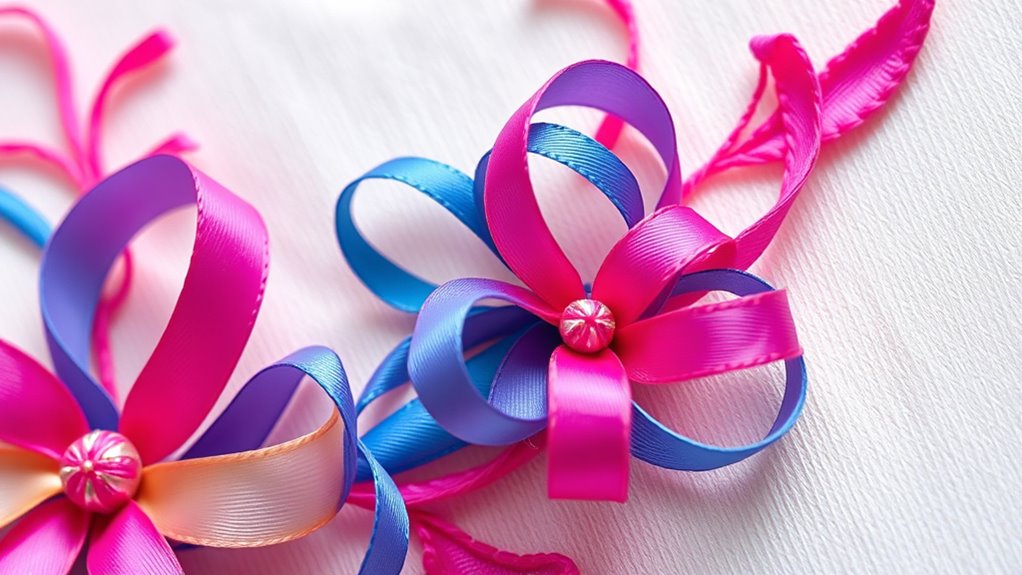
Have you ever wondered how to transform plain fabric into stunning floral designs? The secret lies in choosing the right fabric and having the proper embroidery tools at your disposal. When you start with fabric selection, opt for materials that work well with ribbon embroidery, such as silk, cotton, or linen. These fabrics provide a smooth surface that allows the ribbon to glide easily, ensuring your stitches stay even and neat. Avoid coarse or stretchy fabrics, as they can distort your work and make stitching more difficult. Once you’ve picked your fabric, gather the essential embroidery tools—sharp needles, embroidery hoops, scissors, and a variety of ribbons. A fine embroidery needle with a blunt tip is perfect for threading ribbons through the fabric without damaging the fibers. An embroidery hoop will keep your fabric taut, making it easier to create consistent stitches and preventing puckering.
Before starting your project, take time to familiarize yourself with your embroidery tools. For ribbon embroidery, you’ll need a needle long enough to accommodate the ribbon’s width comfortably. Make sure your scissors are sharp, so you can cut ribbons cleanly without fraying. When selecting ribbons, choose satin or silk ribbons that have a smooth finish and vibrant color. These ribbons will give your floral designs a luxurious, dimensional look. Keep your ribbons free of tangles before you begin, and cut them into manageable lengths to avoid frustration during stitching.
Familiarize yourself with your tools, select smooth ribbons, and keep them tangle-free for flawless embroidery.
Once you have your fabric and tools ready, set up your workspace in a well-lit area to see best while working on intricate details. Secure your fabric in the embroidery hoop, making sure it’s stretched tight but not so much that it distorts the fibers. Thread your needle with a length of ribbon, and start practicing basic stitches like the satin stitch or lazy daisy stitch. These stitches serve as the foundation for more complex ribbon floral designs. Practice controlling your stitches, maintaining even tension, and keeping your ribbon flat against the fabric for a professional finish.
With the right fabric and embroidery tools, you’re well on your way to creating beautiful, dimensional ribbon flowers. Take your time, experiment with different ribbons and stitches, and enjoy the process of turning simple fabric into a work of art. Ribbon embroidery is as much about patience and precision as it is about creativity, so don’t rush. As you become more confident, you’ll discover endless possibilities for adding texture and vibrancy to your textile projects.
Frequently Asked Questions
What Types of Ribbons Are Best for Beginner Embroidery Projects?
For beginner embroidery projects, choose satin or grosgrain ribbons, as they’re easy to handle and hold their shape well. They work best on smooth fabric textures, making stitching simpler. Focus on color coordination by selecting shades that complement your fabric and design. These ribbons allow you to practice creating dimension without frustration, helping you gain confidence and develop your embroidery skills effectively.
How Do I Choose the Right Needle for Ribbon Embroidery?
Choosing the right needle can make or break your ribbon embroidery experience. You want a needle with a sharp point and a large eye—usually a size 16 or 18—so it glides smoothly through fabric and ribbon. Opt for a chenille or crewel needle; these are designed for thicker ribbons and provide better control. Picking the right needle guarantees your stitches are flawless, letting your creativity truly shine.
Can Ribbon Embroidery Be Combined With Other Embroidery Techniques?
Yes, you can definitely combine ribbon embroidery with other techniques to create beautiful mixed media or embroidery fusion projects. You might blend ribbon work with traditional thread embroidery, appliqué, or beadwork to add texture and dimension. Experiment by layering different stitches and materials, which allows you to achieve unique effects. This fusion approach enhances your designs, making them more dynamic and visually interesting, perfect for personalized, creative artwork.
What Are Common Mistakes to Avoid When Starting Ribbon Embroidery?
When starting ribbon embroidery, avoid common technique pitfalls like pulling the ribbon too tight, which can distort your design. Also, make sure you match materials properly; using the wrong ribbon or fabric can hinder your work. Take your time to practice basic stitches, and don’t rush. By paying attention to tension and material choices, you’ll create beautiful, dimensional embroidery without frustration or mistakes.
How Do I Care for Finished Ribbon Embroidery Pieces?
To care for your finished ribbon embroidery, you should use gentle preservation techniques like avoiding direct sunlight and keeping it in a dust-free environment. When displaying, opt for framing or a shadow box to protect it from damage. Regularly dust with a soft brush or cloth, and avoid water or harsh cleaners. Proper care guarantees your ribbon work stays vibrant and beautiful for years to come.
Conclusion
Now that you’ve mastered the marvelous magic of ribbon embroidery, you’re ready to create captivating, textured treasures. With patience and passion, your projects will pop with personality and perfection. Remember, practice paves the path to prettiness, so keep experimenting, exploring, and enhancing your skills. Embrace the beauty of bold, bright stitches and let your creativity blossom. Happy hooping, happy highlighting your handmade masterpieces with the mesmerizing magic of ribbon work!
